Hello everyone!
I’m new in this forum and I have a question that perhaps with the expertise of all bread-fans here can be answered! :)
The thing is it looks like no matter what I do (I’ve tried countless combinations already) my bread always end up having a compact crumb. Not that it’s bad, but I can’t make it lighter no matter what!
I’ve heard many times that the trick is to increase hydration, so this is what I’ve done in my last experiment. Increased it up to 85%...
I follow a modified recipe from Ken Forkish (Overnight White Bread) :
100% - 500 gr Bread white flour (12% proteins)
85% - 425 gr lukewarm water
0.008% - 0.4 gr dry yeast
2.2% - 11 gr salt
· Mix flour and water leave it for 20’ of Autolysis
· Mix all ingredients – 6:45 am
· 9 times delicate coil folding every 30’ min (the dough looked great, super elastic and transparent)
· 1 laminated folding
· During these foldings the dough was kept in a Brod&Taylor proofer at a constant temp of 26°C (78.8F)
· After the last folding I left it rest in the proofer– 12:00am
· After 6h it rose its size to x2.5 its volume. It looked very bubbly and smelt great - 6pm
· Pre-shape, very basic. No flour used, only spray some water. 15 min rest
· Shape “envelope method”. It was complicated but I managed to do it ok. The dough achieved some tension and good shape.
· Put it in a 18 cm (7 inches) diameter round proofing basket
· Let it ferment overnight in the fridge at temp 4°C (39.2F)
· After 10.5h I prepared it for baking it. Finger dent test okish I guess. I looked fine – 5:30am.
· Unfortunately it got stuck into the proofing basked but I managed to release it. However, it looked horrible (as I expected because of the high hydration). I scored it (with a new blade) in a “+” form, spray a bit of water above the dough to provide it with more moist with the expectation of a better oven spring and lighter crumb.
· Put into a Dutch oven pre-heated at 250°C (482F) during 45’
· Bake for 30’ at 250°C (482F)
· Bake outside the Dutch oven for over 20’ at 250°C (482F)
The result is ok, but still it didn’t get the open light crumb I was expecting. The vertical circumference of the bread is 48-49 cm (19 inches), which is exactly the same I get with other levels of hydration (80%, 75%, 70%). I believe that if all else is kept constant, the vertical circumference is a good measure for the crumb openness level.
So, if with 85% hydration is so difficult to handle but gives the same results as 70%, why bother? It looks like to me that hydration is not really the key factor to get a good light crumb.
What are your views on this? Does anyone have some experience on this topic?
Here some photos:
When ready to bake:
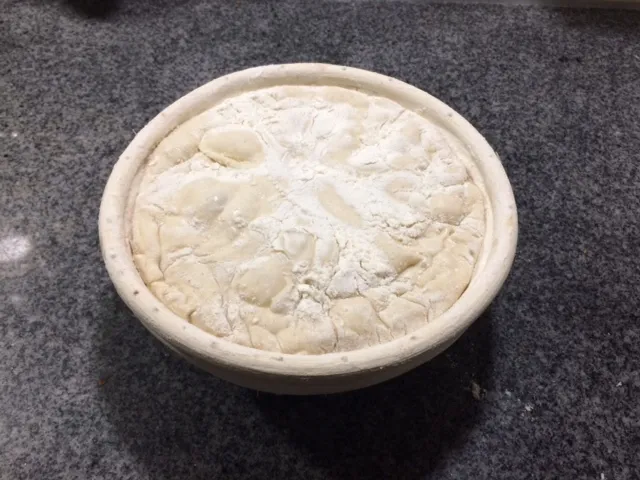
After taking it out from the proofing basket and scoring in + Sorry for the bad quality but I got nervous and was in hurry thinking it would spread all over my counter!
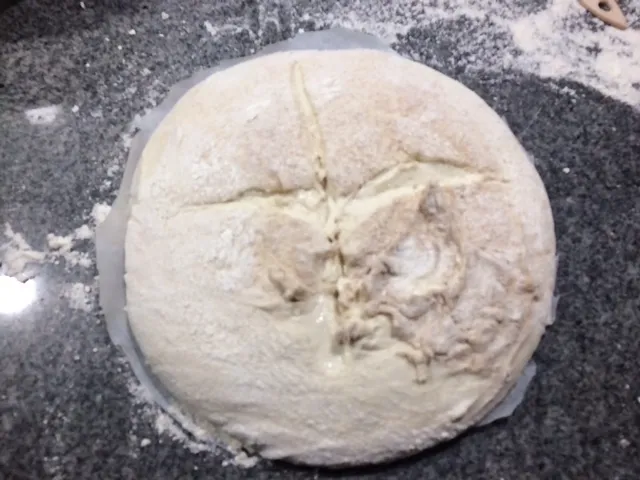
Final result. It looks pretty ok to me
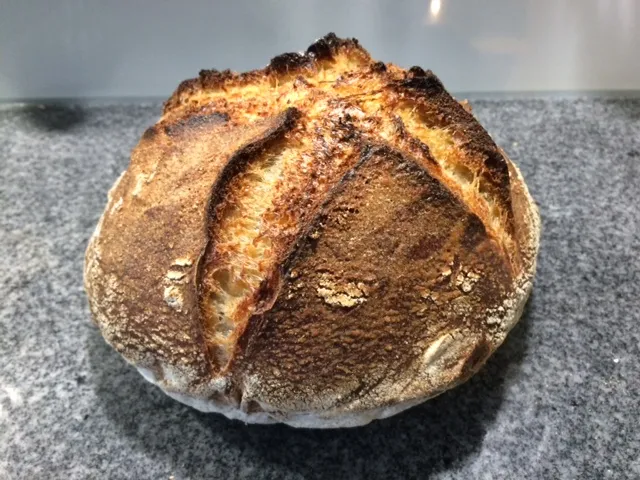
Crumb:
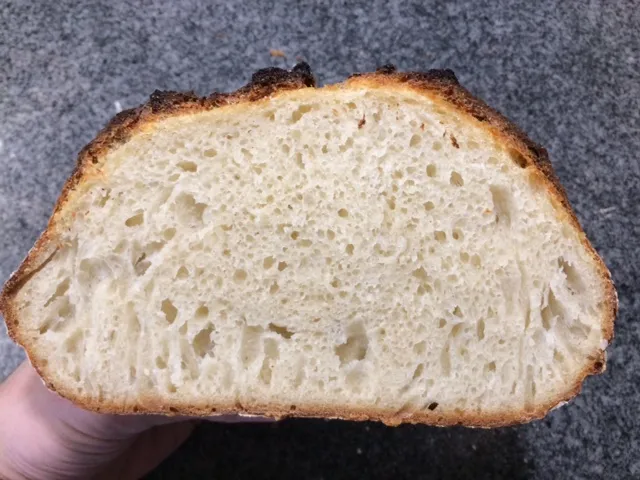
Crumb comparison with other I did yesterday with 80% hydration (85% top, 80% bottom). As you can see they are almost identical! and what it's even more frustrating, the ones I do with less hydration, 75%, look exactly the same!
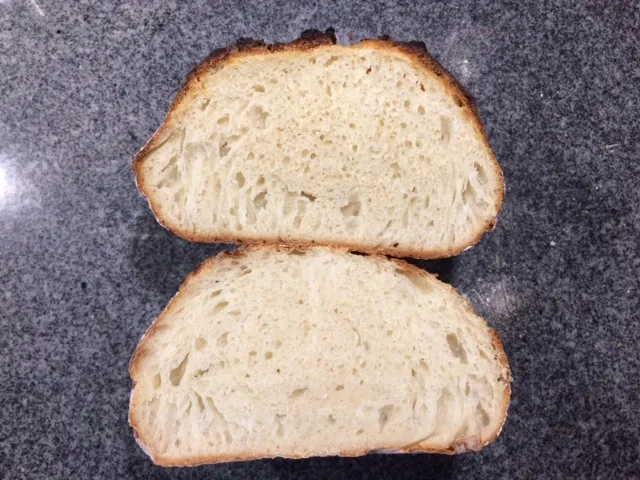
Thanks!
Even though they might look the same, in my experience the springiness as well as shelf life change noticeably if you only change it by a few percent.
My standard sourdough is 68% hydration. It's fairly bouncy, but still firm and it usually stays the same for about 2 days, after that it dries quite fast and becomes tough and chewy.
Then some day I increased hydration to 72% and it instantly became bouncier and softer, and it lasted a good day longer. And this happened on multiple occasions.
I know there are also other factors that affect this, but it's undeniable.
The bubble size is most affected by your kneading method. First, time controls how much gluten is formed. Before someone chimes in with all the factors I missed, this is not a scientific treatise. Time is the major factor in the amount of gluten for a given flour.
Second, kneading helps align the gluten strands, increasing its effective strength. Consider a bundle of sticks to loose sticks. Stretching and folding do this. It also redistributes yeast and flour to insure plenty of food for the little beasties.
Third, and most important to this discussion, kneading is like workers on a chain gang; making little rocks (bubbles) out of big rocks (bubbles). The purpose is not to degas, but to redistribute the gas. Gentleness matters.
When I want big, irregular holes (seldom), I only work the dough (1 stretch and letter-fold) at ten minute intervals during the first 30-40 minutes of the bulk rise. After the bulk rise, I shape with another stretch and fold, cover with a towel for the final, short rise time and tighten the skin. I look for bubbles under the skin and pop them with my thumb nail or knife point, score and put in the oven.
I prefer a small, tight bubble structure, since I am not enamored of mayo or butter and jam dripping on my lap. When I go for a more holey than righteous bread (to impress at family dinners), I use the same hydration, about 65% give or take, as I use for my day to day breads. It's the kneading method I use that makes the difference.
gary
Thanks for your comments.
I believe that it has to do with something else as well... Not sure about the kneading since you can see, I did 9 "coil and fold" so I believe I developed the gluten well.
I have tried another one again today with 90% hydration just to check and guess what, the results have turn out to be the same.
See my last attempt in this picture.
Above 90% hydration
Middle 85% hydration
Bottom 80% hydration
I’m a bit frustrated :)
[quote=Poldarn]I believe that it has to do with something else as well... Not sure about the kneading since you can see, I did 9 "coil and fold" so I believe I developed the gluten well. [/quote]
The problem, as I see it, is too much kneading. You're collapsing larger bubbles, making them small bubbles. I'm not familiar with 'coil' and fold, but for the sake of this discussion, I will presume that it is an analogue of 'stretch' and fold. If true, do your coil and fold to begin your bulk ferment, then three more times at ten minute intervals. That's all. Doing everything else as you have been. You will have plenty of gluten (assuming you're not using cake flour :grin:)
g
Hi Gary
Thanks a lot for your suggestion.
You are right, the "coil and fold" is very similar to stretch and fold but I believe is more delicate. The only reason why I did 9 of those is because in other occasions I have done 2 or 3 stretches and fold (as suggested in the recipe by Forkish) and I got the same results... That's why I thought that with 2 or 3 stretches and fold it might not be enough gluten development and decided to really develop the dough by doing 9
As mentioned, I've tried many combinations and none seem to work :)
I agree with Mr Wilson the tight crumb in the center is a sign of being under proofed. When I went from 10 or 12 hours in the fridge to waiting more than 15 hours I saw improvements. Additional floor time before tucking it in the fridge helped as well. YRMV
That's pretty good for commercial yeast. If anything, it looks a little over-proofed, and over wet. 80% hydration is on the high end for white flour.
To keep the same schedule, reduce the temp of your bulk ferment a bit. Maybe in the range of 73 to 75 F. That will reduce the over-fermentation somewhat.
Also agree with previous commenter about 9 coil folds probably worked the dough too much.
Update:
Poldarn, one of the important things that people who are new to no-knead/long-ferment dough-handling need to incorporate into the way they think-through bread baking, is that "time works the dough" and "time develops gluten."
and... there does come a point where a dough mass can become over-fermented, or become over-worked. And if the over-worked point is reached, you no longer have a good gluten network. So... it's easy to assume gluten hasn't developed, when in fact, it was developed, then over-worked and degraded. And once degraded, (as far as I know) cannot be re-built.
You did well to reduce the yeast, because you had both a 12 hour ferment, and a >10 hour proof. But the warmer-than-room-temp ferment also accelerated fermentation. And such a long time for the ferment+proof plus the more-than-normal folds (usually 3 or 4 for white flour) likely combined to "over work" the dough.
You're on the right track. Just be patient while you "dial it in" (tweak and adjust) to go from "very good" to "great."
Dear idaveindy,
Thanks for your cheerful and interesting comments! I will definitely give a thought and plan how to do my next loaf. In the meantime, you mentioned reducing the temperature for the bulk fermentation to 73-75F. Would you also assume that I should leave it longer so that the dough can still reach x2.5 its volume but with longer time?
I have done experiments with loafs that just duplicated their volume thinking that perhaps the requirements of x2.5 or triple its volume during the bulk fermentation were a bit an exaggeration, but I reached the same results....
Thanks!
With that proposal temperature + the normal amount of hours I leave it for bulk fermentation I doubt it would duplicate its volume
Poldarn,
Perhaps it would be good to state what is your goal at this point.
I previously thought you wanted to depart from Forkish's formula to better match your schedule: a long proof instead of the short proof that he calls for in his formula.
Once you depart from a published formula, each change, in temp or time, changes other things, so if you change "X", then you have to change "Y".
Under proved in all cases.
0.4 grams yeast for 500g of flour = .08% and not "0.008%" as stated.
There is no real proof time since it only sees fridge time for that period.
Have no fear of over-working the dough because there is no real kneading occurring. You need to impart energy to create gluten and too much to break it (depolymerisation).
I think you are suffering from a too cautious approach.
If you want a good cell structure you need to knead.
Hi Mwilson!
Thanks a lot for your comment! You are completely right with the % of yeast. I use a 0.008%
If I was confused before I'm now even more!
All the previous comments suggested that my dough was clearly over proofed and suggested doing fewer stretches and shorten the fermentation time.
Now you think that my dough is clearly under proofed and that it need more stretches and probably more fermentation time since the time in the fridge does not count as a proofing (which it makes more or less sense to me as well).
Do you think then that I should keep everything constant but change my kneading method (or actually include one since I'm now just doing stretches)? Also, perhaps increasing my temperature fridge to allow the proofing? Or proofing actually outside the fridge? Perhaps increase the time of bulk fermentation?
I appreciate a lot of having a different view on this topic!
Thanks
How do you measure 0.008% yeast?
Your bulk is plenty sufficient.
The bread cross-sections show large cells at the bottom. The expanding gas is being restricted by the weight of the dough because it is insufficiently risen. An over-proved dough would show larger cells at the top due to a fully or near collapsed structure which would result in flat and wide loaves. Whereas you have a good dome.
Personally I would shift the fridge time earlier so that you end up with a cold bulk rather than cold proof. I would refrigerate at the point the dough starts to feel "puffy". And after the cold bulk I would allow the dough to come to temperature (approx. 1hr) before shaping and rising at room temperature.
I know that considerably changes the recipe but that is, what I would do. You don't have to do that, but my example may help you to see where you can make changes that you are comfortable with.
Also If you decide to include some kneading (which I highly recommend) do it at the beginning immediately after mixing. You can then follow that with folds if you want...
.4 grams / 500 grams = .0008
.0008 * 100 = .08%
How did you measure the yeast, did you weigh it (grams), or measure it by volume (ml) ?
--
I also am curious as to whether you still wish to follow Forkish's formula, or completely depart from it and work towards another goal.
Hello friends!
Sorry, I got lost with so many 0s… I use 0.4gr per 500gr of flour. That is a 0.08% as idaveindy correctly pointed out. I measure it in a scale with 0.1gr precision, so I’m fairly confident that that is the right amount.
Let me share it with you an experiment I’ve done to try different advices from idaveindy and mwilson. With this attempt I did two breads and I wanted to see:
1. What would happen if I keep the fermentation times the same but the temperature of the 1st bulk fermentation is reduced from 26°C (78.8F) to 23°C (73.4F) (bread1 and bread2)
2. What would happen if I do only 3 “coil and fold” to the dough (bread 1) Vs the breads I did previously with 9 stretches
3. What would happen if instead of the 3 “coil and fold” I do an extensive kneading to the dough (bread 2)
This time, as I saw that hydration does not play any role in the size and lightness of the crumb, I decided to reduce it to 75%, where I feel more comfortable.
The process went as follows:
• 20 min autolysis for both
• Mix all the ingredients
• During 1h I did 3 “coin and folds” to bread 1 at intervals of 15’-20’
• During the same 1h I did about 20’ kneading to bread 2.
Here is how the dough of bread1 looked after the 3 folds:
Here is how the dough of bread2 looks like after the 20 kneading. As you can see, the structure kept breaking:
• I put them both in the proofer box at a constant temp. of 23°C (73.4F)
• After 8h (since mixing) – 9h (since folding/kneading) the doughs looked very similar. Fluffy and nice to handle.
Here is how the dough of bread1 looked after shaping:
Here is how the dough of bread2 looked after shaping. This dough was way nicer to handle, looked like it had better structure and better consistency. I was very curious about the results with this one!
• I left them in the fridge for 12h a temp of 7-8°C (45F). After this time, none of them looked puffy… they looked exactly the same as my previous ones. A bit compact and dense, but the finger print remained unfilled.
Here is how the dough of bread1 looked just before the fridge proofing, after the fridge proofing, and after scoring. It looked like it had a nice well-developed crumb already.
Here is how the dough of bread2 looked just before the fridge proofing, after the fridge proofing, and after scoring. This one looked like it had even more developed crumb!
• I bake them both under the same conditions and same time.
And here were the expected results:
Bread1 - about 49cm of vertical circumference
Bread2 - about 46cm of vertical circumference
Crumb Bread1 VS Bread2:
As you can see, it has been a “failure”! Bread1 has come out bigger than Bread2 but none of them got a lighter open crumb!
Here my conclusions:
• The kneading of Bread2 hasn’t helped at all. I got the exactly same results (if not better) with a simply 3 stretches than after 20’ hard kneading.
• The overdevelopment of the gluten is not probably the cause. Bread1 got way less stretches than my previous bread in this thread the temp. of the bulk fermentation was also reduced.
At this stage and after reading the comments I’m more puzzled than before and unsure if the dough is underproofed or overproofed….
My aim is simply to understand how to make an open lighter crumb. Not because of aesthetic reasons, but because sometimes my breads are a bit too dense, and if I know the key aspect that makes the crumb lighter, I will be able to apply it if needed.
Any ideas? Did anyone go through the same struggle?
Cheers!
Yeast breads produce more even sized holes in general than sourdough. Ciabatta and baguettes being an exception because of their shape and size plus the extra hydration. Your bread is not under proofed this time with a less dense center crumb but it may open the crumb a little more if you proof it even longer. It may flatten out the profile but the smaller bubbles might break down and form larger bubbles. You could try leaving it on the counter for a while longer after turning it out of the basket to let it spread to elongate the holes and then slash just before baking.
Getting an irregular crumb is more in the domain of sourdough bread and difficult to achieve even then.
Cancel that - sorry I just read your comment PROPERLY. Apols can’t see how to delete the post...
I know I sound like mister picky for saying so (sorry!) but surely you can get big holes in a non-SD bread... what about Baguettes a lá Bouabsa for example?
Looks like your flour is very tenacious although that is normal for North American hard wheat.
It is still under under proved. Look at it this way, if you bread didn't collapse and it is denser than you want, then it can only be that you didn't rise it enough... make sense?
What flour are you using? Because of the high tenacity evident in the picture shown after kneading I'm wondering if your flour has any adulterants in it, particularly oxidising agents?
In any case clearly you need much better extensibility. I would cut 40% of your flour with AP.
The kneading made the gluten even tighter hence why it was smaller.
Also the tenacity of this flour is preventing you from developing a good gluten network.
I live in Switzerland, so not sure how the flour here is in comparison with the North American one. I've been using two types in different recipes during the last months, and I always got the same results. One of them a organic bio with 12gr proteins and the other is a normal brand with also 12gr. None of them specify anything about adulterants in their ingredients. Only wheat.
It kind of makes sense that it’s underproofed, yes. However the dough looked kind of collapsed when I took it out from the banneton, so don’t know what to think.. I guess that at some point I'll try to leave it way longer to see what turns out.
What do you mean with AP?
Sorry I assumed wrongly that you were in the US.
AP = all purpose flour.
Do either of these flours have a website so I can check them out? Or just tell me the brand?
Also check your yeast ingredients.
Hi MWilson,
Not sure how good your German skills are, but here you have the links :)
Normal Four:
https://www.coopathome.ch/de/supermarkt/lebensmittel/grundnahrungsmittel/mehl-zucker/mehl/weissmehl/p/3031906
Bio Flour (in the link it says 10gr Proteins, but in the package says 12gr):
https://www.coopathome.ch/de/supermarkt/lebensmittel/grundnahrungsmittel/mehl-zucker/mehl/naturaplan-bio-weissmehl/p/3033271
Yeast. I always use a bio one:
https://www.coopathome.ch/de/supermarkt/lebensmittel/backzutaten/klassische-backzutaten/grund-zutaten/naturaplan-bio-trockenhefe-3x9g/p/6062629
All looks good however since they are COOP branded we don't know the actual miller, might say on the packet...
That bio flour is probably most suitable since it has some Canadian wheat in it.
Still the look of your dough after kneading is troubling me.
In all your pictures both bread and dough everything looks under developed.
Let me say that better. The crumb looks weak and the dough after proving looks weak.
I shall continue to think about this...
from the flour bags. Flour is recommended for cakes and not in particular bread dough. I think the gluten is low in both flours and needs to be combined with stronger mor glutinous flours.
it is a mixture. The interesting thing about that product site, there is choice of language!
https://www.coopathome.ch/en/supermarket/food-cupboard/staples/flour-sugar/flour/naturaplan-organic-rustic-flour/p/3030784?lang=en
or this one?
https://www.coopathome.ch/en/supermarket/food-cupboard/staples/flour-sugar/flour/naturaplan-organic-half-half-flour/p/4320218?refCat=m_0140
The reason why I use that particular type of flour is because is the only one that contains 100% white wheat and I've read in several places that's how you get the best oven spring (and I assume that the better over spring the bigger the loaf and hence the lighter and more open the crumb will be).
I guess that if there is a consensus here in the comments that the issue can be with the flour, I can try with the one in the first link "Naturaplan Organic Rustic Flour" since it contains 90% Semi-white flour and 10% Rye flour, and let's see... This one also contains 13gr of proteins in comparison with the previous one of 12gr.
The flour in the second link "Organic Half-Half Flour" has even a greater amount of proteins with 14gr per Kg but it's made of Ruchmehl which I think it must be something closer to an Integral wheat flour, so not sure it'll work well...
And I bet it tastes great too :-)
As you can make bread that good with commercial yeast, you would probably have a lot of fun having an experiment or two with sourdough
Those two (poldarn's) flours have no malted flour added, and no amylase, and no bran.
Mini's first link has 10% rye flour, with bran, so it has natural enzymes I don't understand the ingredients on Mini's 2nd link.
I thought you were over-fermenting based on the amount of yeast, time, and temperature (your 78 F versus Forkish's 65-68 F).
But since there is nothing in your flour to help/accelerate the breakdown of starch into sugar, now I can see the likelihood it was underfermented. Forkish is writing for an American audience, using American flours, that have malted flour or amylase added.
So kudos to mwilson, who got it right based on the pictures. All my previous comments were off base. But I blame the flour. ?
--
poldarn, can you link to a picture with the crumb you are looking for? You actually have a good crumb. The other commenter who mentioned using sourdough for a more open crumb may have a point.
--
Or, perhaps mwilson (In the UK) or Mini Oven (In Austria) can recommend a work-around, perhaps even the right amount of diastatic malt powder, or other ingredient, to add to bring your Swiss flour up to the enzyme power of American flour. Or perhaps there is another route that European bakers use.
American Formula, with European flour... that was it all along.
--
Though, if you switch to the flour in Mini's first link, you'll have to adjust the hydration a little (back to 78-80% water) and drop your bulk ferment temperature, to more closely match what Forkish recommends.
http://www.thefreshloaf.com/node/51313/bread-switzerland#comment-377377
Thanks a lot mini oven! Sounds very interesting. I might try with a "Ruchmehl" one at some point to see the results.
Here is a picture of a crumb that I have in mind
I'm not particularly interested on it, however I get more often than not a too dense and compact crumb. Hence, my interest to understand why and how to stir my recipes to get a lighter one.
I have already tried several times with sourdough and I must say I'm traumatized xD I got a very similar results (very dense and compact crumb) So I decided to focus on a "simple" white bread recipe with commercial yeast before jumping again to sourdough perhaps some day...
I guess we have a consensus here about the dough being under-proofed and probably due to the type for flour.
I'm going to try with this new one and higher hydration, about 80%.
https://www.coopathome.ch/en/supermarket/food-cupboard/staples/flour-sugar/flour/naturaplan-organic-rustic-flour/p/3030784?lang=en
If it's currently under-proofed I guess I could do some kneading, increase the bulk fermentation temp to 29°C (84F) to accelerate it, extend the cold proofing in the fridge to an extra 12h and even perhaps leave it outside the fridge for about an hour before scoring and baking it... any feedback on this approach? Or should I change it completely? mwilson even suggested doing the bulk fermentation in the fridge, which I find very interesting but I wonder if this won't even retard more the fermentation and prevent a proper gluten development?
"change only 1 thing at a time" is a good rule to follow.
If you use different flour, keep everything else the same. It might be worthwhile to go back to Forkish's exact formula, times, and temperatures. (He said in his book that his kitchen temp goes down to 65 F overnight.)
I have a suspicion that if you use a flour with natural enzymes (that are in the small portion of natural bran) that Forkish's times and temperatures will work for you.
Hi all,
I've tried again with this new type of flour suggested in the comments, which is supposed to have more nutrients:
https://www.coopathome.ch/en/supermarket/food-cupboard/staples/flour-sugar/flour/naturaplan-organic-rustic-flour/p/3030784?lang=en
I have followed the same steps as in the previous bread. This one with 80% hydration.
Dough after kneading it (about 30' of kneading):
Dough before and after of its 13h cold proofing time in the fridge:
I have to say this time has been the first time I felt the dough kind of responding after the time in the fridge. It looked more fluffy and swollen than my previous doughs.
Here when I took out from the proofing basket and scoring:
The consistency here was very pleasant, the dough looked it had some structure and was easy to handle and score.
Here the final results:
So it looks like that the flour has helped a bit but not quite. It has the same height (about 48cm vertical circumference) and crumb looks still very similar to the previous breads, a bit dense.
If we can discard the kneading and flour, perhaps the missing variable is the fermentation time...I'll try to think about how to do it to avoid leaving the dough under developed.... any suggestions in the meantime?
Thanks all for your support and feedback!
No way would I call that a 'compact crumb' - that's a beautiful loaf. Bet it tastes good too?
Jeez stop beating yourself up (big grin)
If you really want very big holes, then I think you might need to change the technique... perhaps have a look at http://www.thefreshloaf.com/node/51627/my-attempts-bouabsas-baguette and adapt that approach to a boule?
Thanks Martin!
To be honest, I wasn't very pleased about the flavor. I guess that this type of flour is a bit too strong to my taste. Otherwise and apart of the crumb, I'm more or less satisfied.
I'll investigate about this baguette and see if I can incorporate anything to my recipe. Thanks!
Hi,
That flour looks better for sure. Thanks to Mini.
If you allow the dough to rise to the same level in the proof why would it make a larger loaf?
Clearly the processing is the remaining hurdle.
Why not just try making a simple loaf? I.e. a higher level of yeast, kneaded and risen in about 3-4 hours. That way you can see what the flour can do in a shorter time-frame.
One more thing I notice... Your dough does not look like 80% hydration, it looks firmer. There doesn't appear to be enough extensibility...
What is your kneading technique?
What is your water quality like?
The structure of your crumb is really weak (craggy). Round alveoli requires at least good gassing pressure and strong gluten.
Thanks for your feedback, and to you and Mini for the flour advice.
Yes, I guess I could try to do a "traditional" recipe and see what happens. The main advantage about my current schedule is that I can fit it very well to my daily life. The need to wait 3-4 for the dough to rise makes it difficult for me to do it during weekdays. I’ll see if I can manage to try it this weekend :)
I used 400gr of water for 500gr of flour. Can it be that this new flour “soaked” more water then normal and hence looked firmer? I use the tab water that we have here in Switzerland which I believe of a good quality.
Not sure how to describe my kneading technique. I’ve been always using the stretch and fold. So what I do is a kind of slap-stretch-fold approach kind of vigorously for about 20' or 30'. It could well be that I’m doing it wrong… However I’ve also read in several places that this does not make much of a different, but hard to say if does…